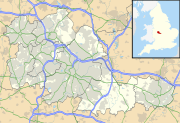Witton, Birmingham facts for kids
Witton is a part of Birmingham, a big city in England. It's located in the West Midlands area. Long ago, it was part of the old parish of Aston in Warwickshire. Witton is famous for being the home of Aston Villa Football Club and their stadium, Villa Park.
Contents
Witton's Past
Witton has a long and interesting history!
Early Days and Owners
- Around the time of the Norman conquest of England (when William the Conqueror took over England), Witton belonged to a man named Staunchel.
- After the conquest, a powerful Norman lord named William Fitz-Ansculf took control of Witton. Staunchel then rented the land back from him.
- Witton was even mentioned in the Domesday Book, a famous survey of England made in 1086. It was called "Witone" back then.
- Later, in 1240, King Henry III gave Witton to Andrew de Wicton. This shows the name of the area was changing.
- Andrew had a disagreement with his neighbor, William de Pyrie, about land. The King asked the sheriffs from nearby areas to help settle the problem.
- Over the years, Witton changed hands many times, belonging to families like the Dixleys and the Pyries.
Old Routes and Land Changes
- Around 1460, people talked about a path through Witton that crossed the River Tame at a place called 'le Foulford'. This is where Witton Bridge was later built.
- In 1559, the Earl of Warwick bought a large area of moorland (open, uncultivated land) in Witton, about 80 acres (32 hectares).
Witton Hall and Schools
- In 1730, Witton had 22 farms and three small houses, plus a larger building called Witton Hall.
- Witton Hall was bought by different families over the centuries. It still stands today where Brookvale Road and George Road meet.
- By 1850, Witton Hall was used as a private school. Later, around 1907, it became a home for elderly people. It continued to be used for this purpose even after the Second World War.
- In 1902, a school for boys called Birmingham Industrial School opened on Witton Lane. It could hold 80 boys, but it only stayed open for about three years, closing in 1905.
Local Church
- In 1907, All Souls' Church on Wenlock Road was officially opened. It was built with red bricks and stone in a Gothic style. It had a main hall (nave), a special area for the altar (chancel), and a small tower.
Witton's Industries
Like many parts of Birmingham, Witton became a busy industrial area, meaning many factories and businesses were built there.
IMI plc
- The industrial company IMI plc had its base in Witton.
- From 1922 to 1929, they built a conveyor (a moving belt for carrying things) next to Witton Brook and also cleaned out the brook. The conveyor was taken down in 1943.
- In 2003, IMI moved its main office from Witton to a new location near Birmingham Airport.
The General Electric Company (GEC)
- The General Electric Co. Ltd. (GEC) bought land in Witton in 1899 and opened an engineering factory in 1901. They even built houses for their workers!
- By 1923, the factory site was huge, covering about 130 acres (53 hectares).
- The main factory made large parts for power stations, like the ones at Nechells.
- GEC also had sports fields for its employees, gardens, and a social club called "Magnet." This club had a theater, dance hall, and even a boxing ring!
- At one point, GEC employed as many as 18,000 people at its Witton site.
Cool Places in Witton
Witton has several interesting spots to visit.
- You can find Witton Cemetery, a peaceful burial ground.
- There are also Witton Lakes, which are nice places to relax.
- The River Tame flows through the area.
- You can still see the remains of the historic Witton Hall.
- Witton railway station helps people travel to and from Witton.
- The Birmingham Bulldogs rugby team trains on Moor Lane in Witton.
- Witton Centre is the main shopping area, with many local shops. While some improvements were made in the 1980s, the area still faces challenges with traffic and parking.
- Many buildings in Witton show the beautiful Victorian and Edwardian styles, reminding us of Aston's past. The Aston Hotel is a well-known building in the area.
Flooding in Witton
- On June 15, 2007, parts of Witton experienced flooding. This happened because of very heavy rainfall, which caused the River Tame to overflow its banks.
- About 300 homes in the Brookvale Road area were affected. The city council gave advice to residents on how to clean up and deal with the costs.
- Some parts of the area were evacuated (people were asked to leave their homes) as a safety measure. Residents could go to Great Barr Leisure Centre, where the council had set up a place for them to rest. However, most people chose to stay in their homes.
- Roads like Brookvale Road, Tame Road, Deykin Avenue, and Brantley Road were flooded.
- The river almost flooded a second time when its water level rose very close to the top of the river bank.

All content from Kiddle encyclopedia articles (including the article images and facts) can be freely used under Attribution-ShareAlike license, unless stated otherwise. Cite this article:
Witton, Birmingham Facts for Kids. Kiddle Encyclopedia.

